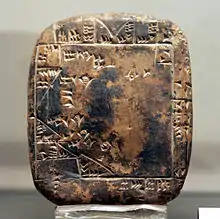اوما
اوما (با نام امروزی امالعقارب واقع در استان ذیقار عراق) شهری باستانی در سومر بوده است. بین باستانشناسان بر سر نام سومری و اکدی این سایت اختلاف وجود دارد.[1]
 نقشهی یک ملک در شهر اوما، به همراه نشانهی سطوح بخشهای مختلف. دودمان سوم اور. موزهی لوور | |
| خطای لوآ در پودمان:Location_map در خط 543: Unable to find the specified location map definition: "Module:Location map/data/عراق" does not exist. | |
| موقعیت | استان ذیقار، عراق |
|---|---|
| منطقه | میانرودان |
| نوع | سکونتگاه |

تاریخ
در متن سومری هبوط اینانا به دوزخ میخوانیم که اینانا شیاطین را از گرفتن شارا، حامی اوما که در آلودگی زندگی میکرد باز میدارد. در نهایت آنها دوموزید چوپان را که در ناز و نعمت میزیست میگیرند.[2]
این شهر که بیش از هر چیز به دلیل درگیری با لاگاش شناخته میشود[3] در حدود سال ۲۲۷۵ پ.م. تحت فرمان لوگال زاگیسی به اوج خود رسید. او شهرهای اور و اوروک را هم در اختیار داشت. اوما هنگام حکومت دودمان سوم اور به مرکز ایالتی مهمی تبدیل شد. بیش از ۳۰ هزار لوحه در این سایت کشف شده که بیشتر آنها موضوعات اداری و اقتصادی دارند. این لوحهها دنیای تازهای را برای پژوهشگران باز کرده تا بتوانند از امور ایالتی این شهر آگاه شوند.[4] گاهشماری اوما مربوط به شولگی (حدود سدهی ۲۱ پ.م.) سلف بلاواسطهی گاهشماری بابلی که بعدها پدیدار شد میباشد. همچنین این تقویم به نوعی جد تقویم یهودیان پیش از تبعید نیز هست. به نظر میرسد اوما بعد از طلوع عصر برنز میانه خالی از سکنه شده است.[5]
منابع
- W. G. Lambert, The Names of Umma, Journal of Near Eastern Studies, vol. 49, no. 1, pp. 75-80, 1990
- Inanna's descent to the netherworld - ETCSL
- Jerrold S. Cooper, History from Ancient Inscriptions: The Lagash-Umma Border Conflict, Undena, 1983, ISBN 0-89003-059-6
- P. A. Parr, A Letter of Ur-Lisi: Governor of Umma, Journal of Cuneiform Studies, vol. 24, no. 4, pp. 135-136, 1972
- Trevor Bryce, The Routledge Handbook of The Peoples and Places of Ancient Western Asia: The Near East from the Early Bronze Age to the fall of the Persian Empire, Routledge, 2009, 738-739.
منابع برای مطالعه بیشتر
- B. Alster, Geštinanna as Singer and the Chorus of Uruk and Zabalam: UET 6/1 22, JCS, vol. 37, pp. 219–28, 1985
- Tonia M. Sharlach, Provincial taxation and the Ur III State, Brill, 2003, ISBN 90-04-13581-2
- Trevor Bryce, The Routledge Handbook of The Peoples and Places of Ancient Western Asia: The Near East from the Early Bronze Age to the fall of the Persian Empire, Routledge, 2009
- B. R. Foster, Umma in the Sargonic Period, Memoirs of the Connecticut Academy of Arts and Sciences, vol. 20, Hamden, 1982
- Georges Contenau, Umma sous la Dynastie d'Ur, Librarie Paul Geuthner, 1916
- Jacob L. Dahl, The Ruling Family of Ur III Umma: A Prosopographical Analysis of an Elite Family in Southern Iraq 4000 Years ago, Nederlands Instituut voor het Nabije Oosten/Netherlands Institute for the Near East (NINO), 2007, ISBN 90-6258-319-9
- Shin T. Kang, Sumerian economic texts from the Umma archive, University of Illinois Press, 1973, ISBN 0-252-00425-6
- Diana Tucker, "Brutal Destruction of Iraq's Archaeological Sites Continues," online article from September 21, 2009 posted on www.uruknet.info, http://www.uruknet.info/?p=58169
